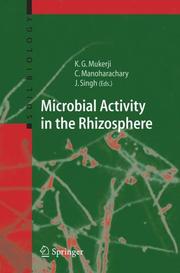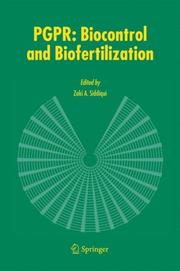| Listing 1 - 4 of 4 |
Sort by
|
Periodical
ISSN: 19489005 Year: 2007 Publisher: Washington, D.C. : U.S. Dept. of Agriculture, Agricultural Research Service
Abstract | Keywords | Export | Availability | Bookmark
 Loading...
Loading...Choose an application
- Reference Manager
- EndNote
- RefWorks (Direct export to RefWorks)
Biogeochemical cycles --- Rhizosphere --- Soil ecology --- Biogeochemical cycles. --- Rhizosphere. --- Soil ecology. --- Appalachian Region. --- Edaphology --- Ecology --- Soils --- Roots (Botany) --- Biogeochemistry --- Cycles --- Environmental aspects --- Appalachia --- Appalachian Mountains Region
Book
ISBN: 9781402067761 1402067755 9781402067754 9048177227 9786612823244 1282823248 1402067763 Year: 2007 Publisher: Dordrecht : Springer,
Abstract | Keywords | Export | Availability | Bookmark
 Loading...
Loading...Choose an application
- Reference Manager
- EndNote
- RefWorks (Direct export to RefWorks)
In the context of increasing international concern for food and environmental quality, use of Plant Growth-Promoting Rhizobacteria (PGPR) for reducing chemical inputs in agriculture is a potentially important issue. PGPR are root-colonizing bacteria that exert beneficial effects on plant growth and development, but they can be also employed in the control of plant pathogens, for enhancing the efficiency of fertilizers, and for degrading xenobiotic compounds. This book provides an update by renowned international experts on the most recent advances in the ecology of these important bacteria, the application of innovative methodologies for their study, their interaction with the host plant, and their potential application in agriculture. Reprinted from European Journal of Plant Pathology, Volume 119, No. 3, 2007.
Life Sciences. --- Plant Pathology. --- Bacteriology. --- Life sciences. --- Plant diseases. --- Sciences de la vie --- Bactériologie --- Plantes --- Maladies et fléaux --- Substance de croissance végétale --- plant growth substances --- Stimulant de croissance végétale --- Plant growth stimulants --- Rhizobactérie --- Rhizobacteria --- Rhizosphère --- Rhizosphere --- Contrôle de maladies --- Disease control --- Plant growth-promoting rhizobacteria. --- Rhizosphere. --- Science: Biology -- Natural History. --- Botany --- Agriculture --- Earth & Environmental Sciences --- Plant Sciences --- Agriculture - General --- Plant Physiology --- Botany. --- Botanical science --- Phytobiology --- Phytography --- Phytology --- Plant biology --- Plant science --- PGPR (Bacteria) --- Plant pathology. --- Biology --- Natural history --- Plants --- Growth (Plants) --- Microbiology --- Communicable diseases in plants --- Crop diseases --- Crops --- Diseases of plants --- Microbial diseases in plants --- Pathological botany --- Pathology, Vegetable --- Phytopathology --- Plant pathology --- Vegetable pathology --- Agricultural pests --- Crop losses --- Diseased plants --- Phytopathogenic microorganisms --- Plant pathologists --- Plant quarantine --- Pathology --- Diseases and pests --- Diseases --- Wounds and injuries

ISBN: 1280608757 9786610608751 3540294201 3540291822 3642067166 Year: 2006 Volume: 7 Publisher: Berlin ; New York : Springer,
Abstract | Keywords | Export | Availability | Bookmark
 Loading...
Loading...Choose an application
- Reference Manager
- EndNote
- RefWorks (Direct export to RefWorks)
The rhizosphere is a very complex environment in which the effects of the plant on soil microorganisms and the effects of the microorganisms on the plant are interacting and are interdependent. Plant root exudates and breakdownproducts attract microbes and feed them and, in turn, the plants often bene?t from the microbes. Interactions among microorg- ismsandplantrootsareessentialfornutritionalrequirementsoftheplant. Plant growth, development and productivity are largely dependent on the soil environment in the root region rhizosphere. The new techniques of studying the rhizosphere enables us to get a much better understanding of the dynamics of the rhizosphere population, such rhizosphere studies beingofinteresttoagriculturists,soilbiologists,chemists,microbiologists andmolecularbiologists. The rhizosphere microbes in?uence the root environment in several ways. They may change the oxidation-reduction potential, in?uence the availabilityofmoistureandnutrients,producegrowthinhibitingorgrowth promoting substances in the form of exudates, provide competition and possiblyinducemanyothereffects.Mycorrhizalassociationsarebene?cial in mineral uptake and in increasing root surface area for effective ion absorption. Antagonism,competitionandsynergisminsoilandtherhizoplane(r- zosphere) are the most important microbial interactions to consider in the study of rhizosphere biology. With the growing information on the production of growth regulators, competitiveness of the microbes in the rhizosphere, microsymbionts, and other factors, their effect upon plant growth will become more evident. Experiments on the introduction of microbes or their products in the rhizosphere will help to improve our understandingofthebiologyoftherhizosphere.
Soil microbiology. --- Rhizosphere. --- Rhizobacteria. --- Mycorrhizal fungi. --- Soil fungi --- Rhizosphere bacteria --- Bacteria --- Soil microbiology --- Roots (Botany) --- Soils --- Soil micro-organisms --- Soil microorganisms --- Microbiology --- Soil biology --- Soilborne plant diseases --- Bacteriology --- Ecology. --- Microbial ecology. --- Botany. --- Plant diseases. --- Soil conservation. --- Agriculture. --- Microbial Ecology. --- Plant Sciences. --- Plant Pathology. --- Soil Science & Conservation. --- Farming --- Husbandry --- Industrial arts --- Life sciences --- Food supply --- Land use, Rural --- Conservation of soil --- Erosion control, Soil --- Soil erosion --- Soil erosion control --- Agricultural conservation --- Soil management --- Botany --- Communicable diseases in plants --- Crop diseases --- Crops --- Diseases of plants --- Microbial diseases in plants --- Pathological botany --- Pathology, Vegetable --- Phytopathology --- Plant pathology --- Plants --- Vegetable pathology --- Agricultural pests --- Crop losses --- Diseased plants --- Phytopathogenic microorganisms --- Plant pathologists --- Plant quarantine --- Botanical science --- Phytobiology --- Phytography --- Phytology --- Plant biology --- Plant science --- Biology --- Natural history --- Environmental microbiology --- Microorganisms --- Ecology --- Balance of nature --- Bionomics --- Ecological processes --- Ecological science --- Ecological sciences --- Environment --- Environmental biology --- Oecology --- Environmental sciences --- Population biology --- Control --- Prevention --- Conservation --- Pathology --- Diseases and pests --- Diseases --- Wounds and injuries --- Ecology . --- Plant science. --- Plant pathology. --- Soil science. --- Pedology (Soil science) --- Agriculture --- Earth sciences --- Floristic botany

ISBN: 1280460164 9786610460168 1402041527 1402040024 9048170095 Year: 2006 Publisher: Dordrecht : Springer,
Abstract | Keywords | Export | Availability | Bookmark
 Loading...
Loading...Choose an application
- Reference Manager
- EndNote
- RefWorks (Direct export to RefWorks)
PGPR have gained world wide importance and acceptance for agricultural benefits. These microorganisms are the potential tools for sustainable agriculture and the trend for the future. Scientific researches involve multidisciplinary approaches to understand adaptation of PGPR to the rhizosphere, mechanisms of root colonization, effects on plant physiology and growth, biofertilization, induced systemic resistance, biocontrol of plant pathogens, production of determinants etc. Biodiversity of PGPR and mechanisms of action for the different groups: diazotrophs, bacilli, pseudomonads, and rhizobia are shown. Effects of physical, chemical and biological factors on root colonization and the proteomics perspective on biocontrol and plant defence mechanism is discussed. Visualization of interactions of pathogens and biocontrol agents on plant roots using autofluorescent protein markers has provided more understanding of biocontrol process. Commercial formulations and field applications of PGPR are detailed.
Plant growth-promoting rhizobacteria. --- Rhizosphere. --- PGPR (Bacteria) --- Rhizobacteria --- Growth (Plants) --- Roots (Botany) --- Soils --- animal growth promoters --- Root systems --- Disease control --- Biological control --- Fertilizer application --- Nitrogen fixation --- Agriculture. --- Microbiology. --- Bacteriology. --- Plant diseases. --- Botany. --- Life sciences. --- Plant Pathology. --- Plant Sciences. --- Life Sciences, general. --- Biosciences --- Sciences, Life --- Science --- Botanical science --- Phytobiology --- Phytography --- Phytology --- Plant biology --- Plant science --- Biology --- Natural history --- Plants --- Botany --- Communicable diseases in plants --- Crop diseases --- Crops --- Diseases of plants --- Microbial diseases in plants --- Pathological botany --- Pathology, Vegetable --- Phytopathology --- Plant pathology --- Vegetable pathology --- Agricultural pests --- Crop losses --- Diseased plants --- Phytopathogenic microorganisms --- Plant pathologists --- Plant quarantine --- Microbiology --- Microbial biology --- Microorganisms --- Farming --- Husbandry --- Industrial arts --- Life sciences --- Food supply --- Land use, Rural --- Pathology --- Diseases and pests --- Diseases --- Wounds and injuries --- Plant pathology. --- Plant science. --- Floristic botany
| Listing 1 - 4 of 4 |
Sort by
|

 Search
Search Feedback
Feedback About UniCat
About UniCat  Help
Help News
News